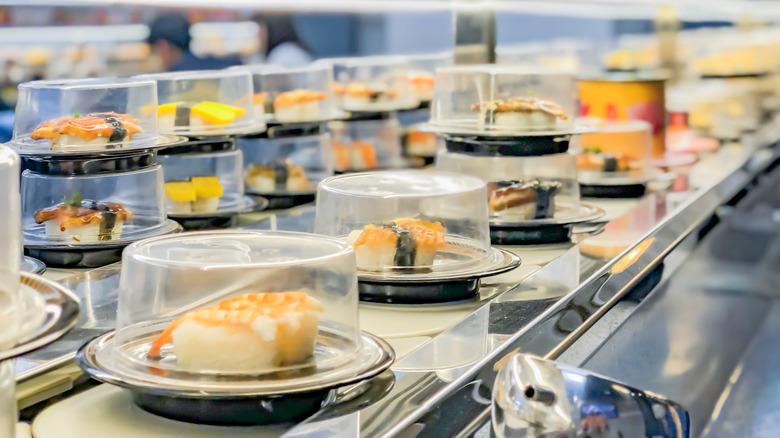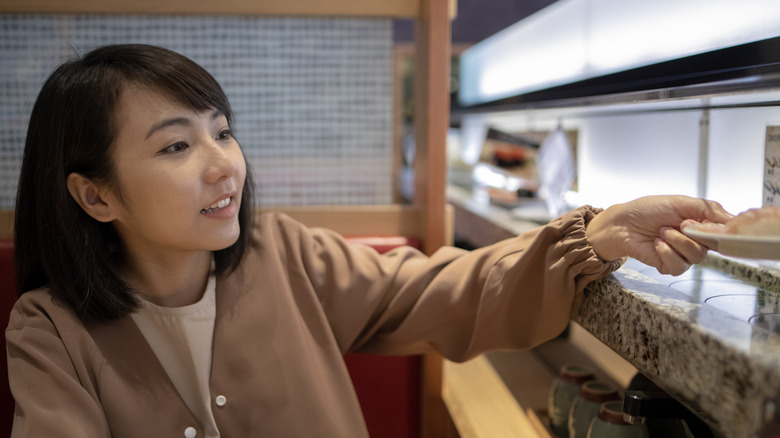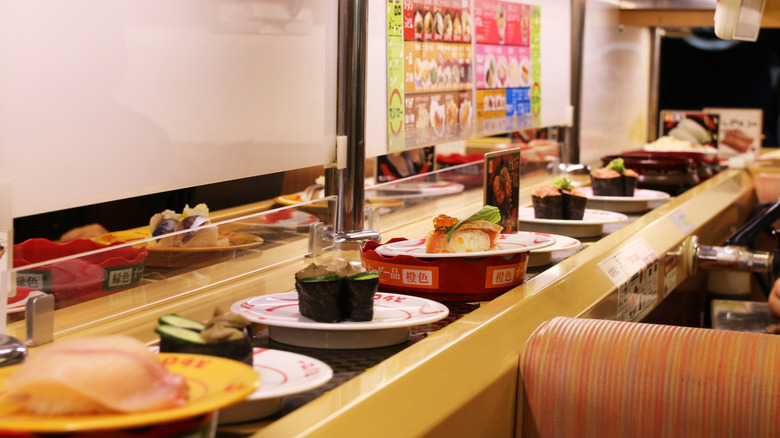The Beer-Inspired Origins Of Conveyor Belt Sushi
Conveyor sushi, also known as kaiten-zushi, or rotation sushi, is partially to thank for sushi becoming one of the most influential international dishes of all time. This style of dining has dishes that travel on a rotating belt around a bar, allowing guests to serve themselves. Yoshiaki Shiraishi, the restauranteur who pioneered the practice, was inspired after seeing how conveyor belts were used to move beer bottles in an Asahi brewery. He'd had trouble staffing his small restaurant and was looking for a more efficient way to serve guests. After four years of brainstorming, designing, and prototyping, he was ready to share his invention with the culinary world.
Shiraishi's first conveyor sushi restaurant, Mawaru Genroku Sushi, opened in Osaka in 1958. The original design had no chairs around a central bar with a horseshoe-shaped, stainless steel belt. The belt moved clockwise to account for the fact that many people held chopsticks in their right hand and could grab plates with their left. It moved at a speed of just over three inches (eight centimeters) per second – a rate that ensured freshness without causing accidents. Little did he know that his unique food delivery system would forever change the way people eat sushi.
Sushi for the people
Yoshiaki Shiraishi's invention revolutionized sushi service, turning the traditional luxury cuisine into a quick and nutritious meal that was affordable for everyday people. The rotation sushi restaurants did away with the frills and formality while adding an element of entertainment with the novelty of mechanized self-serve. It also appealed to the growing cultural obsession with efficiency and innovation, showcasing how new technology might save time and money for business owners and patrons alike.
The Osaka World Expo in 1970 saw millions of people from around the world flock to the city. It was the perfect place for Shiraishi to showcase his kaiten-zushi creation to an international audience. He opened one of his restaurants at the fair, and the exposure increased the popularity of the practice exponentially. His rotation sushi restaurant chain, Genroku Sangyo, had 240 locations across Japan at its peak and inspired other restauranteurs to adopt similar conveyor systems.
Rotating sushi around the world
Though Shiraishi passed away in 2001, he lived to see his humble invention spread throughout Japan and overseas. His patent on the conveyor system expired in the mid-70s, allowing copy-cats to get in on the trend. Competing kaiten-zushi restaurants opened up around the country, and new chains popped up across Asia, Europe, and the Americas. As sushi spread around the globe, new cultural influences meant new iterations of the traditional cuisine, such as New York and California rolls. Today, rotation sushi restaurants can be found in more than a dozen countries, with more than 4,000 restaurants of this type in Japan alone in 2016 (per SeafoodSource).
While there are many common sushi questions consumers ask about the cuisine, Shiraishi's invention helped to globalize the Japanese specialty. Today, the market is dominated by four big conveyor sushi chains in Japan, but Yoshiaki Shiraishi's is not one of them. By 2001, only 11 Mawaru Genroku locations were in operation, including his original shop in the Chuo Ward of Osaka. But true to Shiraishi's vision of quick, affordable food, visitors can still enjoy fresh sushi for less than a dollar a plate.



